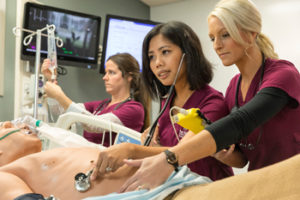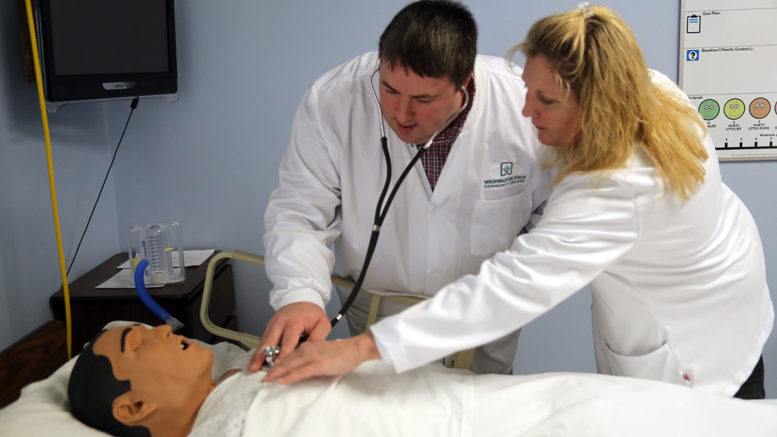Community college programs leading to an associate degree in nursing (ADN) are thriving across the country, despite the push by some hospital and university groups to make a baccalaureate the entry-level degree to a nursing career.
When a task force convened by the American Association of Colleges of Nursing (AACN) issued a draft policy statement in December calling for all nurses to attain at least a bachelor’s degree, advocates of community college nursing programs objected. The Academic Progression Task Force received more than 100 comments from community colleges, statewide community college associations and national organizations, including the American Association of Community Colleges, highlighting the value of the ADN.
In one example of a letter to the task force, William Scroggins, president of Mt. San Antonio College, a two-year institution in California, wrote: “There is no evidence that the associate degree as the credential for entry into the nursing profession is not preparing students to successfully handle the responsibilities of the job and that the baccalaureate degree, with its focus on general education courses, will better prepare a nurse.”
Scroggins also noted that not all hospitals require the BSN for new nurses. Also, the recommendation fails to take into account the importance of the role of the ADN in rural areas, in fostering diversity in the profession and in doctors’ offices, nursing homes and other non-hospital healthcare facilities.
AACN will take the comments from community colleges into account when it issues a final recommendation, said spokesperson Robert Rosseter, who serves as staff liaison for the task force.
“We do listen to what folks have to say,” Rosseter said. “We understood there was language that was offensive.”
The task force never intended for the ADN to go away, he said, and it stands by a 2012 joint policy statement it signed, along with AACC and other national groups, endorsing academic progression and affirming a “seamless transition” into associate degree and more advanced programs.
High demand for ADNs
Students who complete an ADN or a one-year practical nursing certificate from Fox Valley Technical College (FVTC) in Wisconsin are in high demand among local employers, said Zoe Cujak, dean of health and public safety.
“We are very fortunate our students have done really, really well with our licensure programs,” Cujak said.
In fact, FVTC had one of the top pass rates in the the country between April and September 2017 on the national licensing examination for registered nurses (NCLEX-RN) among 1,899 two and four-year U.S. nursing programs. It also was among the top-scoring programs in passage rates on the practical nursing licensing exam during the same period.
Cujak attributes that success to the college’s dedicated nursing faculty. “They do a lot of retention strategies, such as boot camps for struggling students, and use data to make changes that improve the program.” For example, she said, if faculty notice enough students having trouble with electrolytes, they invite students to a voluntary, all-day session on that topic before the semester begins.
Cujak also credits the college leadership’s willingness to provide funding for nursing facilities with state-of-the art equipment. FVTC has a human patient simulator lab with 14 lifelike robotic patients that have a pulse and eyes that constrict when a light is shone on them.
FVTC is very supportive of professional growth opportunities for faculty, Cujak added. A couple of faculty members are visitors for the Accreditation Commission for Education in Nursing (ACEN), which allows them to help evaluate other two-year nursing programs. “That really helps us,” she said. “They are on top of what ACEN is looking for.”
“What I hear from agencies in our area is that our students can hit the ground running when they start. They are a little more prepared than students from four-year colleges,” she said. “We get very good feedback from our advisory committee and agencies that hire our students. They are well-prepared and ready from the get-go.”
“We encourage lifelong learning, but we don’t think nurses need a four-year degree to be successful,” she noted. There are plenty of opportunities to take advantage of hospitals’ tuition reimbursement programs if students want to pursue a BSN later.
College adds BSN option
In other areas, community colleges are facilitating academic progression by offering a BSN degree if allowed by state law. Delaware Technical Community College, which has about 600 students in its nursing program, added a BSN program in January 2017 in response to employers’ needs, said Jo Ann Baker, instructional director for nursing.
Incoming students are told that all hospitals in Delaware require nurses to complete a BSN within three to five years of employment, Baker said. “Before they even start, they know that is the expectation.”

Nursing students at Fox Valley Technical College practice their skills on a robotic patient. (Photo: FVTC)
Graduates of Delaware Tech with ADNs have a 95 percent employment rate. The college has articulation agreements with four universities, most of which offer a BSN online, but now that nurses can earn a bachelor’s degree at Delaware Tech, it’s less expensive and more convenient.
All hospitals in the state give nurses who want to pursue a BSN flexible schedules and provide 100 percent tuition reimbursement, usually up to $5,000 a year, which would cover the entire cost at Delaware Tech, Baker said. Among the college’s most recent BSN class, 98 percent of students graduated from its ADN program.
High standards
Hospitals in the rural Ohio area served by the nursing program at Washington State Community College (WSCC) prefer nurses with BSNs, says nursing program director Darla Boone.
But there’s a nursing shortage, “so our graduates don’t have any trouble getting hired,” she said. To meet the demand, some hospitals are turning to international nurses, mostly from the Philippines, or “travel nurses,” who are certified in several states and employed by a travel agency.
The shortage is due to several factors: The aging population means a greater demand for healthcare, and more nurses are nearing retirement age.
WSCC’s ADN program not only has a 100 percent job placement rate, it has an average NCLEX-RN pass rate of more than 97 percent over the past three years. The program also recently ranked in the top 10 among RN education programs in the state by RegisteredNursing.org – beating much larger institutions, such as Ohio State and Ohio University.
The success of WSCC’s ADN program is due to its exceptional standards, Boone said. Also, “We are a very small program, so we can give our students more individualized attention.”
RNs with BSNs and those with ADNs work in the same positions, but nurses with BSNs are more prepared for management-type positions and in some hospitals are paid slightly more, although the difference generally comes to less than a dollar an hour, she said.
“Both four-year and two-year nursing programs are highly competitive,” Boone noted, “but we’re there for the student who needs to be near home.”
Boone attributes the push for BSNs to an increase in “patient complexity” and the need for more technical skills. “It’s challenging for community colleges to step up to that, but that’s what we’re doing,” she said, noting that WSCC has a simulation lab with robotic patients.
“It’s a wonderful opportunity for a lot of students to go through the associate degree program first,” she said. The entire ADN program at WSCC costs just $18,000, which is less than a single year at a university. That’s important because so many students receive financial aid.
“An ADN program is a good opportunity for students to achieve a well-respected job with a relatively smaller financial commitment,” Boone said.

